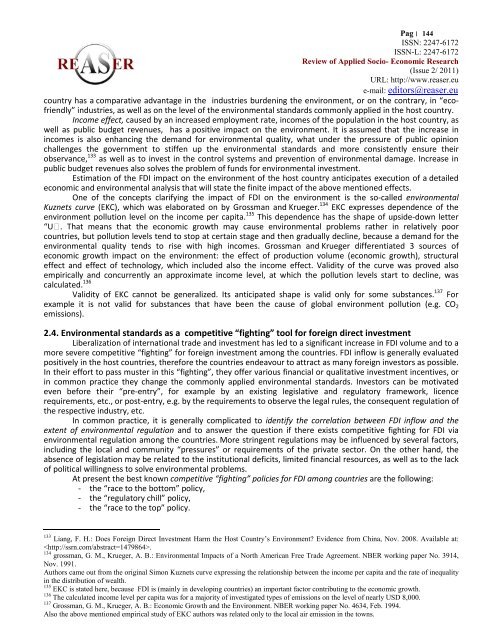Volume 2, ISSUE2/2011 - Review of Applied Socio-Economic ...
Volume 2, ISSUE2/2011 - Review of Applied Socio-Economic ...
Volume 2, ISSUE2/2011 - Review of Applied Socio-Economic ...
You also want an ePaper? Increase the reach of your titles
YUMPU automatically turns print PDFs into web optimized ePapers that Google loves.
Pag׀ 144 ISSN: 2247-6172ISSN-L: 2247-6172<strong>Review</strong> <strong>of</strong> <strong>Applied</strong> <strong>Socio</strong>- <strong>Economic</strong> Research(Issue 2/ <strong>2011</strong>)URL: http://www.reaser.eue-mail: editors@reaser.eucountry has a comparative advantage in the industries burdening the environment, or on the contrary, in “ec<strong>of</strong>riendly”industries, as well as on the level <strong>of</strong> the environmental standards commonly applied in the host country.Income effect, caused by an increased employment rate, incomes <strong>of</strong> the population in the host country, aswell as public budget revenues, has a positive impact on the environment. It is assumed that the increase inincomes is also enhancing the demand for environmental quality, what under the pressure <strong>of</strong> public opinionchallenges the government to stiffen up the environmental standards and more consistently ensure theirobservance, 133 as well as to invest in the control systems and prevention <strong>of</strong> environmental damage. Increase inpublic budget revenues also solves the problem <strong>of</strong> funds for environmental investment.Estimation <strong>of</strong> the FDI impact on the environment <strong>of</strong> the host country anticipates execution <strong>of</strong> a detailedeconomic and environmental analysis that will state the finite impact <strong>of</strong> the above mentioned effects.One <strong>of</strong> the concepts clarifying the impact <strong>of</strong> FDI on the environment is the so-called environmentalKuznets curve (EKC), which was elaborated on by Grossman and Krueger. 134 EKC expresses dependence <strong>of</strong> theenvironment pollution level on the income per capita. 135 This dependence has the shape <strong>of</strong> upside-down letter“U . That means that the economic growth may cause environmental problems rather in relatively poorcountries, but pollution levels tend to stop at certain stage and then gradually decline, because a demand for theenvironmental quality tends to rise with high incomes. Grossman and Krueger differentiated 3 sources <strong>of</strong>economic growth impact on the environment: the effect <strong>of</strong> production volume (economic growth), structuraleffect and effect <strong>of</strong> technology, which included also the income effect. Validity <strong>of</strong> the curve was proved alsoempirically and concurrently an approximate income level, at which the pollution levels start to decline, wascalculated. 136Validity <strong>of</strong> EKC cannot be generalized. Its anticipated shape is valid only for some substances. 137 Forexample it is not valid for substances that have been the cause <strong>of</strong> global environment pollution (e.g. CO 2emissions).2.4. Environmental standards as a competitive “fighting” tool for foreign direct investmentLiberalization <strong>of</strong> international trade and investment has led to a significant increase in FDI volume and to amore severe competitive “fighting” for foreign investment among the countries. FDI inflow is generally evaluatedpositively in the host countries, therefore the countries endeavour to attract as many foreign investors as possible.In their effort to pass muster in this “fighting”, they <strong>of</strong>fer various financial or qualitative investment incentives, orin common practice they change the commonly applied environmental standards. Investors can be motivatedeven before their “pre-entry”, for example by an existing legislative and regulatory framework, licencerequirements, etc., or post-entry, e.g. by the requirements to observe the legal rules, the consequent regulation <strong>of</strong>the respective industry, etc.In common practice, it is generally complicated to identify the correlation between FDI inflow and theextent <strong>of</strong> environmental regulation and to answer the question if there exists competitive fighting for FDI viaenvironmental regulation among the countries. More stringent regulations may be influenced by several factors,including the local and community “pressures” or requirements <strong>of</strong> the private sector. On the other hand, theabsence <strong>of</strong> legislation may be related to the institutional deficits, limited financial resources, as well as to the lack<strong>of</strong> political willingness to solve environmental problems.At present the best known competitive “fighting” policies for FDI among countries are the following:- the “race to the bottom” policy,- the “regulatory chill” policy,- the “race to the top” policy.133 Liang, F. H.: Does Foreign Direct Investment Harm the Host Country’s Environment? Evidence from China, Nov. 2008. Available at:.134 grossman, G. M., Krueger, A. B.: Environmental Impacts <strong>of</strong> a North American Free Trade Agreement. NBER working paper No. 3914,Nov. 1991.Authors came out from the original Simon Kuznets curve expressing the relationship between the income per capita and the rate <strong>of</strong> inequalityin the distribution <strong>of</strong> wealth.135 EKC is stated here, because FDI is (mainly in developing countries) an important factor contributing to the economic growth.136 The calculated income level per capita was for a majority <strong>of</strong> investigated types <strong>of</strong> emissions on the level <strong>of</strong> nearly USD 8,000.137 Grossman, G. M., Krueger, A. B.: <strong>Economic</strong> Growth and the Environment. NBER working paper No. 4634, Feb. 1994.Also the above mentioned empirical study <strong>of</strong> EKC authors was related only to the local air emission in the towns.








